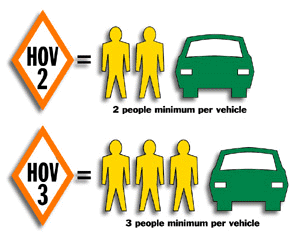High Occupancy Vehicle (HOV) Systems
When and where | Rules and FAQs | How to use | Park and Ride | Contact us
HOV - Northern Virginia: How to Use
Share a Ride
 During HOV-restricted periods, HOV-2 lanes require a minimum of two people per passenger vehicle and HOV-3 lanes have a minimum of three. Some vehicles have exemptions.
During HOV-restricted periods, HOV-2 lanes require a minimum of two people per passenger vehicle and HOV-3 lanes have a minimum of three. Some vehicles have exemptions.
During all other times, HOV lanes are open to all passenger vehicles, except when the reversible lanes are closed.
Many vehicles already have enough passengers, making the HOV lanes an easy way to speed up the trip.
If you're a commuter and need to find a rideshare partner, contact Commuter Connections in Northern Virginia. This organization has a database that can help match you with riders with similar commutes. By ridesharing, you will not only save time, but money.
Plan your Trip
Virginia HOV lanes are on the busiest sections of Interstates 66, 95, 395, and the Dulles Toll Road in Northern Virginia. If you've never taken HOV lanes before, it's easy to plan your trip by checking the detailed schedules for Northern Virginia.
Look for HOV Symbols
   |
   |
HOV lanes are always marked with the HOV symbol. Many lanes also have large electronic message signs which display the required occupancy for using the lanes, the hours that HOV restrictions are in effect, and where to enter and exit.
Some HOV lanes are barrier-separated, while others are simply in the left lane. Message signs will advise if the lanes are open or closed.
The Virginia Department of Transportation closes all entrances to barrier-separated HOV lanes for a short time while the directions are being switched to ensure all vehicles have completed their trip out of the lanes before opening them to traffic in the opposite direction.
Then, VDOT drives the lanes to make sure no cars are left behind. HOV lanes also have emergency shoulders which are monitored by Virginia State Police and VDOT's incident response team.
Questions?
Contact the VDOT Northern Virginia office at: [email protected]



